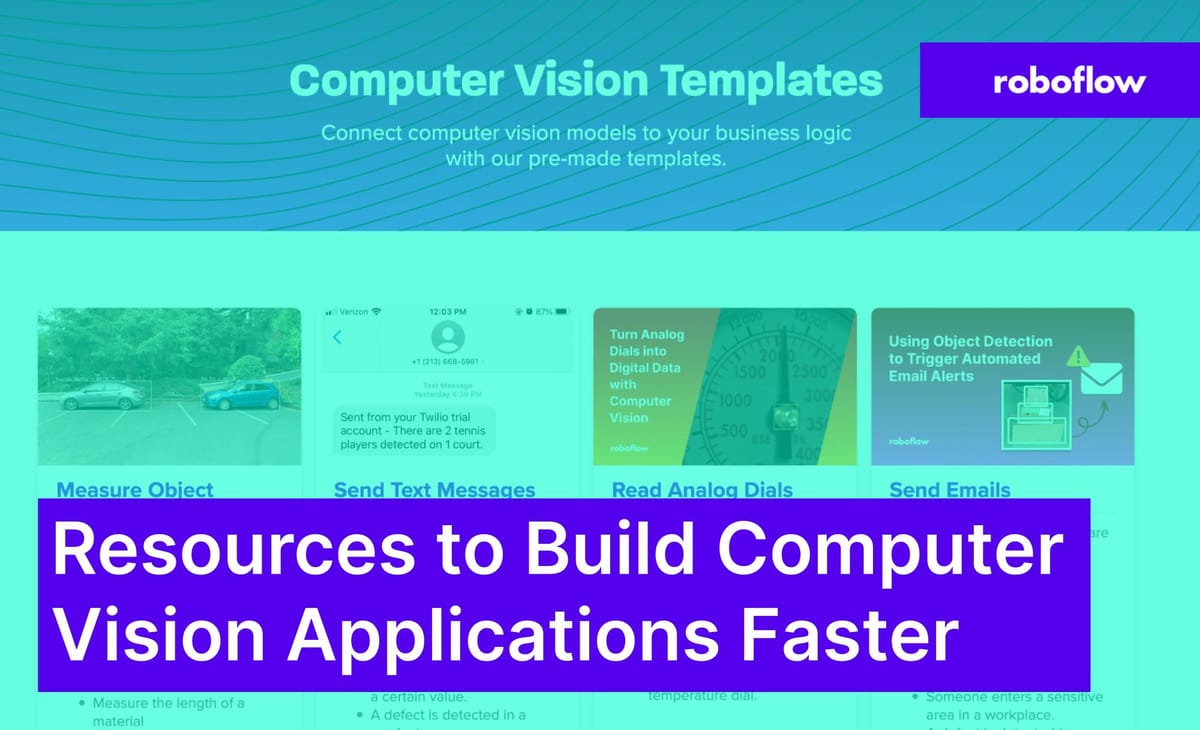
Today, we are excited to announce the launch of four new resources to help you build computer vision applications faster than ever:
As part of our mission to democratize computer vision, the Roboflow team frequently asks itself one big question: how can we reduce the time spent between having an idea for computer vision to solve a problem and implementing a production-ready solution? We strive towards reducing the friction associated with using computer vision.
With the launch of Utilities, Templates, Research, and Showcase, we aim to provide you with more information to show what is possible with computer vision – in production and research contexts – and provide resources to help you execute common tasks.
In this guide, we’re going to talk through what Roboflow Utilities, Templates, Research, and Showcase are, and how you can use them to find inspiration and guidance for use in building projects. Let’s get started!
Roboflow Utilities: Guides to Complete Common Tasks
Once you have a model ready to integrate into an application, there is work to do to integrate that model with your production pipeline. At this stage, there are many boilerplate tasks you may need to complete to prepare your model for use, including:
- Adding a crop feature to retrieve regions of interest;
- Running inference on a folder of images;
- Drawing bounding boxes on an image (bounding boxes don’t come from a model, they are drawn on in a post-processing step!);
- Tracking objects in a video;
- And more.
Roboflow Utilities is a repository of tutorials written by our team and community members that focus on solving a specific problem pertaining to computer vision. These guides focus more on the “how” of implementing a particular common task, with reference to code snippets, examples, and interactive applications. Utilities are focused on inference and post-processing.
Roboflow Templates: Detailed Code and Walkthroughs
With all of the post-processing you need in place, the next question to answer is “what do I do next with my predictions?” To help you out, we have prepared a Templates directory. Templates features over a dozen written guides that walk through what to do after you have predictions from your model.
In the Templates directory, you will find guides covering topics such as:
- How to control OBS with a computer vision model;
- Visualizing object paths;
- Reading values on analog dials;
- Sending text messages when a prediction is made;
- And more.
The guides in Templates are detailed walkthroughs explaining how to complete a task that uses the results of your predictions. There are also a few guides on data and training that may be useful for specific project types such as aerial imagery.
Some templates are coupled with YouTube videos and GitHub repositories, providing you with more information to help you use the predictions returned by your model in a full application.
Roboflow Showcase: Explore Interesting Projects from the Community
Every day, we see interesting projects in the computer vision community; our team is perpetually excited seeing computer vision used to solve real-world problems. Even though computer vision is a technology that can be applied to any industry, it's helpful to see examples with data and use cases specific to your domain.
Roboflow Showcase is a library of projects built by community members using Roboflow across industries. In Showcase, you will find projects such as:
- Detecting hard hats using a MaaxBoard Mini;
- Running an object detection model on an OAK-D;
- Creating smart glasses to help blind people detect obstacles;
- An automatic dog treat dispenser;
- And more.
If you are looking for inspiration for your next project, or for information about other projects that may help you solve a problem you are experiencing, Showcase is worth reviewing. Remember to check back every so often as we will add more projects that excite us to the directory.
Roboflow Research: Computer Vision in Academia
From recognizing satellite components to identifying plant health, computer vision has vast utility in the world of research.
Using Roboflow Research, you can find research papers which incorporate and utilize Roboflow. Publications including IEEE, Nature, and Aerospace Research Central contain hundreds of published research papers showing how to use computer vision to solve novel problems. Roboflow Research divides papers into categories according to their field, providing a seamless way through which you can find papers that align with your interest.
Conclusion
Computer vision has the potential to impact every industry in ways both big and small. At Roboflow, we are committed to producing and aggregating as much content as possible to show how to solve common computer vision problems so that you can build applications faster than ever.
Using Utilities, Templates, Showcase, and Research, you can find guides on accomplishing tasks and explore real-world applications of computer vision.
Cite this Post
Use the following entry to cite this post in your research:
James Gallagher. (Mar 27, 2023). Resources to Build Computer Vision Applications Faster. Roboflow Blog: https://blog.roboflow.com/computer-vision-learning-resources/
